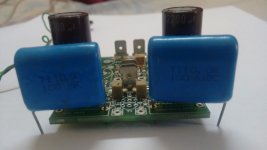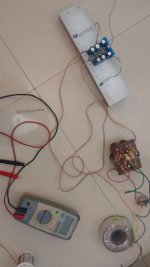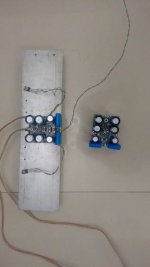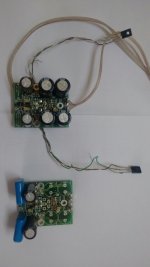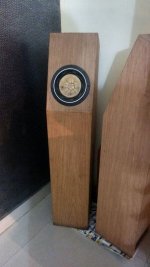Dave,
Unlike the electronic testing here where if you do actually have good modeling software simulation of linear circuits you can get very accurate sims,in composites it is a three dimensional problem with many con-founders. No two pieces of woven fabric are exactly alike and you have a combination of elements that interact in very unusual ways. Shrinkage of resin by itself is different in the xyz directions and this is problem enough by itself, though that can be fairly accurately predicted as a lone factor. Now add in variation in weave and placement of multiple layers of that at alternating angular placement and you start to see the computation leaves much to be desired. You could predict a range of values but it really only give you a min and max set of numbers, no way to control for the real variables in actual production. As I said it will get you in the ballpark but I don't see that it will ever predict anything like the values you can here in electronics with known values once you understand all the parasitic factors you must consider.
I am not saying what all of you working in ltspice or other sims can not get you there, but as you say and others you also have flawed models and the variation from batch to batch and manufacturers variation between what are supposed to be identical products. It sure isn't easy and I give anyone who is solving any of these problems a lot of credit for the efforts needed.
Unlike the electronic testing here where if you do actually have good modeling software simulation of linear circuits you can get very accurate sims,in composites it is a three dimensional problem with many con-founders. No two pieces of woven fabric are exactly alike and you have a combination of elements that interact in very unusual ways. Shrinkage of resin by itself is different in the xyz directions and this is problem enough by itself, though that can be fairly accurately predicted as a lone factor. Now add in variation in weave and placement of multiple layers of that at alternating angular placement and you start to see the computation leaves much to be desired. You could predict a range of values but it really only give you a min and max set of numbers, no way to control for the real variables in actual production. As I said it will get you in the ballpark but I don't see that it will ever predict anything like the values you can here in electronics with known values once you understand all the parasitic factors you must consider.
I am not saying what all of you working in ltspice or other sims can not get you there, but as you say and others you also have flawed models and the variation from batch to batch and manufacturers variation between what are supposed to be identical products. It sure isn't easy and I give anyone who is solving any of these problems a lot of credit for the efforts needed.
Last edited:
...only for a controversy ?
No. It's very simple.
If one wants to do an article of publishable quality then one of the first steps is to search for earlier work.
This has 2 objectives.
First so as not to waste time with useless repetition of earlier work.
Second so as to properly credit the contributions of earlier workers.
So I asked who had done accurate simulations or had accurate data.
I have not found either so far, only irrelevant diversions.
So I have started on the work myself, as you demanded.
Also I will publish, you can read it in Linear Audio I hope.
And since you have been so insistent on publication, I repeat my enquiry.
What have you published, other than "selfie"?
Best wishes
David
I was talking about publishing your VSSA results HERE. Means in this thread.And since you have been so insistent on publication, I repeat my enquiry.
What have you published, other than "selfie"?
I'm not interested in a contest of who has the biggest. Neither to know if you are a journalist of the Times magazine.
You came in this thread, asking where to find simulations of the VSSA (witch is not my design) , presenting yourself like a simulation's expert (that i am not). I brought to you links to my ASC files in order you can save your time to simulate this amp yourself.
Instead of thanking-me for the help, till this moment, you just bring b..s..., noise, criticisms about my own work, and no datas.
And, again, my work was not about VSSA, but comparing and explaining various CFA topologies or improvements of this Lazy Cat's nice VSSA.
I can be wrong in the conclusions of my articles, but you do not provide any datas leading-me to reconsider them.
Welcome in my ignore list.
Last edited:
...in composites it is a three dimensional problem with many con-founders.
Yes, I have only played a little with composites but a friend specialises in this at a local university.
Hard problem but I expect the aerospace industry will throw money and effort until they have it pretty accurate.
That's what they have done with simulations of the entire aircraft and they now routinely achieve remarkable accuracy.
Planes are built almost directly from simulations.
Saw an interview with an aerospace simulation expert.
He was ashamed to admit that sometimes he was incorrect by nearly one percent!
It sure isn't easy ...any of these problems a lot of credit for the efforts needed.
I am very impressed by Mike E. - the LTSpice mastermind.
There's lots of smart, hard work in that product, I try to respect that and do my best too.
Best wishes
David
Just to give a little better view of what goes on in aerospace composites here is some of what is done. Typically today most structural composite parts are made of epoxy resin and carbon fiber. The epoxy resin is well known and has been analyzed for shrinkage in the different axis, as a neat resin that can be predicted with very good accuracy. The carbon fibers used in most applications these days are uni-directional fibers, each layer has the fibers running in one direction and stitched together to hold them in place. This stitching itself is a problem as the tension across the fibers is hard to control and can be changing across the fabric. Now the fibers themselves are controlled very well for diameter as it is drawn trough a die of set size while manufacturing the fiber and the exact count of fibers in a fiber bundle are also very well controlled. The material is usually cut by CNC cutters on a long table and you can accurately cut the pieces to size with reciprocating cutters. These pre-cut pieces are assembled into what is called a kit and this is sent to production. The individual layers take predetermined layers that are set at exacting angles for each later, typically 0,45,90,45,0 angles between layers with a balance between outer to inner and back layup schedules. A laser projector is used to align each layer, it is projected onto the tool that is used for layup. After layup the stack is contained in a complex bagging system that allows for excess resin to be extracted by use of vacuum pressure contained in a vacuum bag made of fairly stiff material that has to conform to the shape of the tooling. Now you attach a set of vacuum hoses through that membrane and have to pull vacuum on the material. This stack of material and molds is then placed in an autoclave a large pressure vessel where pressure is applied with nitrogen gas and the stack has a vacuum draw applied while pressurized externally and heated at a specific ramp rate both up and down while the pressure stays applied and the vacuum is modulated or removed during consolidation and curing.
This is the most controlled situation and using the uni-directional materials this is about as good as it gets. Now add in some of the other types of woven fabrics like basket woven materials and you will start to get a picture of what it takes to make some advanced composite parts.
I've had to write the instructions for producing these types of parts, it is a fairly complex system and you can see where simulation does come in handy for prediction of the final outcome. To bad there are all these confounders that mess that all up.
This is the most controlled situation and using the uni-directional materials this is about as good as it gets. Now add in some of the other types of woven fabrics like basket woven materials and you will start to get a picture of what it takes to make some advanced composite parts.
I've had to write the instructions for producing these types of parts, it is a fairly complex system and you can see where simulation does come in handy for prediction of the final outcome. To bad there are all these confounders that mess that all up.
Last edited:
... your VSSA results HERE[/B]. Means in this thread.
Why would I publish in Vendor's Bazaar when I am not a vendor?
I'm not interested.... Neither to know if you are a journalist of the Times
I didn't mention my publications until you demanded, repeatedly "Why don't you publish?"
... to you links to my ASC files in order you can save your time to simulate this amp yourself.
Instead of thanking-me for the help, till this moment
This is simply incorrect. Post #3411
I did consider to repeat my thank you, and am sorry now that I did not, but you didn't offer help until after you complained that criticism was "nonsense", ,"schizophrenic", "waste of time" that "bored" you.Thank you for the link....
Best wishes
David
So the help looked very reluctant, you can perhaps understand my lack of effusiveness.
...improvements of this Lazy Cat's nice VSSA.
I also think it is a nice circuit and would like to improve it.
The problem is that you seem to consider any comments on how to improve your work as a criticism and attack, this makes it very hard.
Best wishes
David
Hi Dave Zan
Improving VSSA within concept of a simple CFA would be very hard since original VSSA means to use top components as offered in my group buy. If you did not experienced it in real, measurements and listening tests, you would not know how good it is. First One is improved VSSA, higher power, also lower THD.
Be careful what you do with VSSA since this is well known amp, derivates not counting.
Regards, L.C.
Improving VSSA within concept of a simple CFA would be very hard since original VSSA means to use top components as offered in my group buy. If you did not experienced it in real, measurements and listening tests, you would not know how good it is. First One is improved VSSA, higher power, also lower THD.
Be careful what you do with VSSA since this is well known amp, derivates not counting.
Regards, L.C.
... First One is improved VSSA
Is there a published circuit for the First One or is it proprietary?
Be careful what you do with VSSA since this is well known amp
Yes, I respect your intellectual property, my idea is not really a VSSA so I won't call it that.
I wanted to see what the standard is.
Best wishes
David
Any news LC ? I will need 6 mono amplifiers for my next project, I don't know if I go on a VSSA through-hole or your new version.
Not much place (compact active speakers), so I'm wondering what will be the best for me... It can quickly raise up to 1000€ with PSU
Regular VSSA 1.4 would be nice, but no chance you find 6 lost PCB
Anyway I'm keeping an eye here.
Not much place (compact active speakers), so I'm wondering what will be the best for me... It can quickly raise up to 1000€ with PSU
Regular VSSA 1.4 would be nice, but no chance you find 6 lost PCB

Anyway I'm keeping an eye here.
Sorry, no VSSA left on the stock, last sold in 2014. Please consider First One v1.4 M (230 W, 50 x 100 mm) or v1.4 S (120 W, 50 x 70 mm) variant to fit in your compact active speakers. M available now, S most likely in September. The market for power amp modules is simply too demanding to stick to VSSA any longer. We had to switch to more sophisticated CFA topology to be more up to date.Any news LC ? I will need 6 mono amplifiers for my next project, I don't know if I go on a VSSA through-hole or your new version.
Not much place (compact active speakers), so I'm wondering what will be the best for me... It can quickly raise up to 1000€ with PSU
Regular VSSA 1.4 would be nice, but no chance you find 6 lost PCB
Anyway I'm keeping an eye here.
Found 6 VSSA 1.4
Manudrz,
Have 6 of LC's VSSA v1.4 in original plastic bags unassembled, if it suits your need you welcome to buy them i still have two modules for myself to enjoy : )
Suggest contact via PM if interested.
Lazy Cat,
Not dependable above look forward try new S batch when available and will need order four modules then : )
Manudrz,
Have 6 of LC's VSSA v1.4 in original plastic bags unassembled, if it suits your need you welcome to buy them i still have two modules for myself to enjoy : )
Suggest contact via PM if interested.
Lazy Cat,
Not dependable above look forward try new S batch when available and will need order four modules then : )
My adventures with VSSA
Dear Friends,
During the first group sale of VSSA, back in May 2013, I purchased a pair of ready assembled (Except Semiconductors and Elcos) PCBs from LC. I talked to Sri Guru Prasad (diyaudio id - rao gurappa) who is in contact with me as we are both from Hyderabad. He came to my house, saw the PCBs and semiconductors, and promised to do the assembly with required elcos as he is having them in stock. He took the PCBs and all parts, and two Heat sinks, which can be used.
After a month or so, Rao told me that he is in regular contact with Mr Samuel Jayaraj of Bangalore. That recently he expressed interest in assembling and testing VSSA of LC. So, he had sent off my VSSA boards etc to Mr Samuel Jayaraj. I was in Email and whatsapp contact with Mr Jayaraj, from that time.
On 31-3-2015, @11-07 PM, I received this message on whatsapp:
"Dear Mr. Anji, my most sincere apologies for putting you through much distress and frustration. I am really sorry for causing an unnecessary rift between Guru and you. I had put off all electronics for some months now and in the bargain had also packed off the VSSA kit after fully assembling one channel. Everyday I had hoped to complete my other preoccupations and complete the testing of the boards; but this was not to be. Today after getting a terse message from Guru, which I deserved, I began work in the afternoon. I have completed assembly of the second channel. Tested and played one channel. Plays mids and highs very, very good. Bass is a bit lose though defined. I will test the second channel in a little while. Here are some pictures. Sorry once again. Thanks".
The pictures he sent are attached.
Mr Jayaraj promised to send back my VSSA boards today and I shall post my impressions after receiving and hearing to them in my system.
Request Jayaraj, if he sees this post to give here his full impression and the way he tested and the source and Loudspeakers used during his listening test.
--gannaji.
Dear Friends,
During the first group sale of VSSA, back in May 2013, I purchased a pair of ready assembled (Except Semiconductors and Elcos) PCBs from LC. I talked to Sri Guru Prasad (diyaudio id - rao gurappa) who is in contact with me as we are both from Hyderabad. He came to my house, saw the PCBs and semiconductors, and promised to do the assembly with required elcos as he is having them in stock. He took the PCBs and all parts, and two Heat sinks, which can be used.
After a month or so, Rao told me that he is in regular contact with Mr Samuel Jayaraj of Bangalore. That recently he expressed interest in assembling and testing VSSA of LC. So, he had sent off my VSSA boards etc to Mr Samuel Jayaraj. I was in Email and whatsapp contact with Mr Jayaraj, from that time.
On 31-3-2015, @11-07 PM, I received this message on whatsapp:
"Dear Mr. Anji, my most sincere apologies for putting you through much distress and frustration. I am really sorry for causing an unnecessary rift between Guru and you. I had put off all electronics for some months now and in the bargain had also packed off the VSSA kit after fully assembling one channel. Everyday I had hoped to complete my other preoccupations and complete the testing of the boards; but this was not to be. Today after getting a terse message from Guru, which I deserved, I began work in the afternoon. I have completed assembly of the second channel. Tested and played one channel. Plays mids and highs very, very good. Bass is a bit lose though defined. I will test the second channel in a little while. Here are some pictures. Sorry once again. Thanks".
The pictures he sent are attached.
Mr Jayaraj promised to send back my VSSA boards today and I shall post my impressions after receiving and hearing to them in my system.
Request Jayaraj, if he sees this post to give here his full impression and the way he tested and the source and Loudspeakers used during his listening test.
--gannaji.
Attachments
So, after this long and pointless discussion we are back to where we started - even if a preamp has low output impedance but requires cap coupling, a power amp with high input impedance is just greatAfter all a pair of nice 4.7-6.8uF couplers can easily be more expensive than a pair of power amps.
A builder here has already replaced the inputs with k170/j74 in a low voltage VSSA. In order to avoid cascoding and more drastic changes to the pcb i proposed k246/j103. Will probably just build it on a proto board.
hello, i try this with peeceebee. (actually, my own drawing but very much like peeceebee) it work, sound great, but bias creeps, jfet heats and amp become unstable. how fix this? using k246/103 with 32v psu
- Home
- Vendor's Bazaar
- VSSA Lateral MosFet Amplifier

